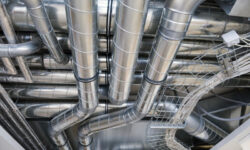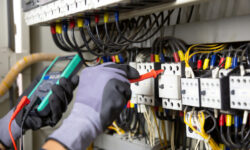Hydronic heating systems are highly regarded in commercial buildings for their efficiency, comfort, and versatility. These systems utilize water or a water-based solution to transfer heat throughout a facility, offering a consistent and controlled heating environment. While used in both residential and commercial spaces, for the purpose of this content, we will focus on commercial use. We will discuss design considerations and benefits of hydronic heating systems, providing valuable insights for businesses looking to implement this effective and reliable heating solution.
Read more →Heat Recovery Ventilation (HRV) and Energy Recovery Ventilation (ERV) systems are vital for modern buildings. They provide fresh air while conserving energy, helping maintain indoor air quality, reduce energy costs, and enhance overall comfort. Let’s explore what HRV and ERV systems are, their applications, and their benefits.
Read more →In the rapidly evolving landscape of commercial building management, efficiency and sustainability have become paramount. One of the key technologies driving these goals is the Building Automation System (BAS). BAS integrates various building systems, including heating, ventilation, and air conditioning (HVAC), to optimize performance, reduce energy consumption, and enhance occupant comfort. Let’s delve into BAS’s critical role in managing commercial HVAC systems.
Read more →Backflow prevention is a critical aspect of commercial plumbing systems that ensure the safety and quality of the water supply. Backflow occurs when water flows opposite from its intended path, potentially allowing contaminants to enter the clean water supply. This can lead to serious health risks and significant financial consequences for businesses. Effective backflow prevention measures are essential for maintaining a safe and reliable plumbing system.
Read more →Plumbing problems in a commercial setting can be more than a minor inconvenience—they can lead to significant business disruptions, costly repairs, and revenue loss. Whether it’s a retail store, an office building, or a large industrial complex, maintaining an efficient and functional commercial plumbing system is crucial for business operations. Commercial plumbing faces unique challenges, unlike residential systems, due to higher usage volumes, complex installations, and stringent health regulations.
Read more →In the realm of modern comfort, few inventions rival the impact of air conditioning. From commercial buildings to offices, shopping malls to hospitals, air conditioning systems have become indispensable fixtures, regulating indoor temperatures and fostering environments conducive to productivity, relaxation, and well-being.
Read more →Regarding home comfort, we often focus on the big players: the furnace, the air conditioner, and the thermostat. But what about the unsung hero of your HVAC system? Enter ductwork – the silent, winding network that delivers heated or cooled air to every room in your building.
While it may not get the attention it deserves, ductwork plays a crucial role in the efficiency and effectiveness of your heating, ventilation, and air conditioning system. Let’s investigate why ductwork is truly the heart of your HVAC system.
Read more →The importance of an efficient HVAC (Heating, Ventilation, and Air Conditioning) system cannot be overstated in commercial and industrial spaces. From maintaining comfortable indoor temperatures to ensuring optimal air quality, HVAC systems are critical in creating a conducive environment for employees and customers. However, achieving this requires more than just off-the-shelf solutions. Enter design-build HVAC systems – a customized approach that offers tailored solutions ideally suited to your business needs.
Read more →Insulation’s impact on commercial buildings is frequently overshadowed by its role in residential settings. However, this oversight can lead to misconceptions about the efficiency of large structures and open spaces. Contrary to common assumptions, proper insulation is a pivotal factor in optimizing the performance of your commercial HVAC system.
Insulation’s impact on commercial buildings is frequently overshadowed by its role in residential settings. However, this oversight can lead to misconceptions about the efficiency of large structures and open spaces. Contrary to common assumptions, proper insulation is a pivotal factor in optimizing the performance of your commercial HVAC system.
Effective and properly installed insulation not only enhances HVAC efficiency but also yields substantial energy savings, all while ensuring a consistently comfortable indoor environment. In this article, we will delve into the crucial role that proper insulation plays in commercial HVAC systems and demonstrate how it can be a catalyst for cost reduction and energy efficiency.
Read more →Heating, ventilation, and air conditioning (HVAC) systems are crucial in maintaining indoor comfort and air quality. These systems rely heavily on electrical connections to function efficiently. Circuitry issues can pose serious safety risks and compromise the reliability of your HVAC equipment despite the safe design of HVAC systems. Read on to learn why they are significant, what the safety concerns are, and how to prevent issues.
Read more →









